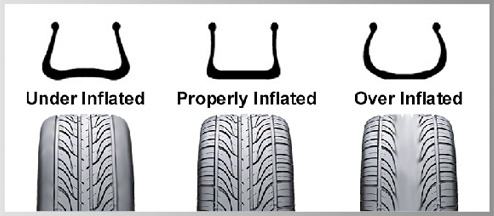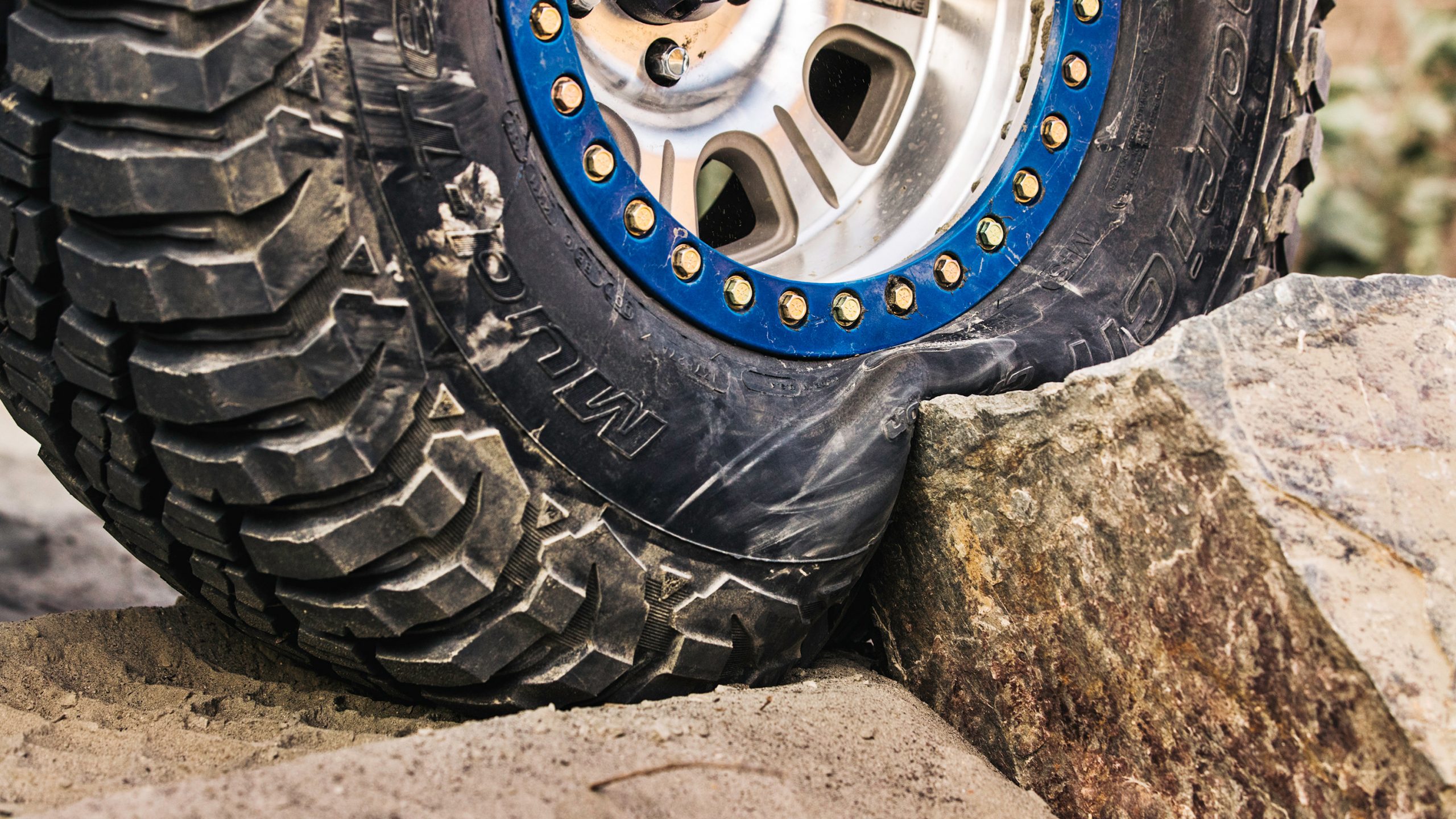The tyre pressure is one of the simplest and most important things you can do to keep your tyres in good shape. Failure to maintain the correct tyre pressure can result in fast and uneven wear. Furthermore it can also affect handling, braking and also ride comfort.
Underinflated tyres – can cause excessive heat build up and premature tyre wear, as well as poor braking and handling.
Overinflated tyres – are more susceptible to punctures and will cause a harsher ride.

Recommended Tyre Pressure
Most vehicles will have a placard indicating the recommended tyre size, type and respectively the pressures. The main function of this recommended tyre pressure is for load capacity of the tyres (to ensure they can carry the vehicle safely). These Placards are usually located in one of the following three positions:
- Glovebox lid.
- On the B pillar (drivers/passengers side door – the body side; where the door closes and locks onto).
- On the inside of the fuel flap.
The numbers will either be in bar, kPa or Psi. If not specified these tyre pressures are “When Cold”. Tyres heat up as your drive long distances and therefore the pressure will increase, so always ensure you set your tyre pressures when Cold.
What happens when you lower your tyre pressure?
- You increase the footprint of your tyre (length of the footprint). Giving you less force per square meter on the ground resulting in less pressure exerted on the ground.
- Protect your tyre from punctures – the less pressure in the tyre, the more the tyre can deform around obstacles like rocks or sticks (this makes it less likely to get punctured or tear of lugs of tread).
- Traction – the less air you have in the tyre, the more contact area you have with the ground and less chance of wheel spin.
- Create a softer more comfortable ride.

Tyre Pressure for Different Terrain
While reducing tyre pressure can increase vehicle performance, comfort and tyre life in different terrain. You must always consider how you plan to re-inflate the tyres back to tarmac pressures when you hit the tarmac.
If you do not have your own compressor; or no way to re-inflate when you hit the tarmac, you may be better off not lowering your tyre pressures at all.
We have indicated a pressure range for each surface (the ideal pressure for your vehicle will depend on your vehicle weight, the speed you will be travelling and the recommended tarmac pressure for your specific vehicles’ stock tyres).
- Soft Sand – (10psi to 18psi) The softer the sand, the larger the tyre footprint you need to stop yourself digging in.
- Hard Sand – (16psi to 25psi) Depending on the speed you are travelling at, you can reduce the pressure to prevent you digging into the sand. Reduce pressures in line with the Max Speed with Low Pressures section below.
- Rocks or rocky roads – (18psi to 25psi) The lower tyre pressure will give you more grip and allow the tyres to flex around the rocks reducing the chances of puncturing the tyres.
- Mud – (16psi to 25psi) The lower tyre pressures give you a larger footprint and more traction. Again this will depend on the type of mud, for some types of mud higher tyre pressures are better; as they allow you to cut into the hard surface below. Another factor
- Gravel roads/Tracks – (road psi) If you are travelling at highway speeds then you should keep highway pressures. But if you wish to increase comfort you can reduce pressures in line with the Max Speed with Low Pressures section below.
- Corrugated Roads – (18psi to 35psi) Reducing the tyre pressure will soften the ride, making it more comfortable and placing less stress on your vehicle components. The pressure will depend on the speed you travel (refer to Max Speed with Low Pressures), if speeds are similar to highway speeds, then do not lower the pressures too much.
- Highway/Tarmac – (30psi to 40psi) This should be as per your vehicle placard and the load you are carrying.
Weight and Tyre psi
The heavier your vehicle the higher the psi you will need to run to maintain the same contact area between the tyre and the terrain.
Therefore the rear of your vehicle should be running a lower unloaded tyre pressure and a higher loaded tyre pressure. (refer to your vehicle placard)
Maximum Speed with Low Pressures
- Less than 16psi – max speed should be 50km/h
- 16 – 25psi – max speed 70km/h
- 25-30psi – max speed of 80km/h (unless your vehicle placard states otherwise).
Other Factors to Consider
- If your vehicle is heavier than stock (the pressures you should run will be higher than what is recommended by the vehicle manufacturer-for stock tyres).
- If you are running larger rims than stock (with the same diameter tyre)– then you should be more careful when lowering tyre pressures (as you run a greater risk of the tyre coming off the rim)
- At lower tyre pressures you should not corner hard as the tyre runs a higher risk of coming off the rim.
- Fuel consumption – under inflated tyres will cause worse fuel economy (as they provide more resistance)
- Larger tyres than stock (may not need to be inflated as high as the Placard indicates, as they will be able to carry a greater load than the stock tyres). However the issue of them heating up (because they are underinflated) should still be a consideration.
- Consider the maximum tyre inflation indicated on your tyres (NEVER inflate more than this value).
- Towing – if you are towing you should increase your tyre pressures.
Conclusion
Tyre pressure for different terrain isn’t an exact science, and you will get different answers depending where you look. The main thing is to understand the function of reducing the pressure; then you can decide how low or how high to go (depending on your speed, vehicle weight and the terrain surface).
When changing your tyre size compared to stock the load carrying capacity of the new tyre will be different; so it is worth finding out what pressure the new tyre needs to have to be able to carry the same load as the old tyre (at the recommended pressure-according to the vehicle placard).
One of the best ways to figure out what the correct tyre pressures are for your modified vehicle (with different rim and tyre sizes) is to do the chalk test (see video below)
References
- Cooper Tyres. https://www.coopertires.com.au/media/1400/cooper-drivers-guide-tyre-pressures.pdf
- Cars Guide Australia https://www.carsguide.com.au/toyota/landcruiser/tyre-pressure
- Practical Motoring Australia https://practicalmotoring.com.au/car-advice/how-to-4×4-tyre-pressures-for-all-terrains-explained/
- 4 Wheeling Western Australia https://www.youtube.com/watch?v=BAXRjNHIUw8&list=PL37ReXkiPpmgzmzi5scRtNHJCDG0z5dCq&index=128
- 4 Wheel Parts https://www.4wheelparts.com/a/tire-wheel-package-guide-tire-pressure-checker
- Axle Addict https://axleaddict.com/auto-repair/Checking-Tire-Pressures-Aftermarket-Wheels


